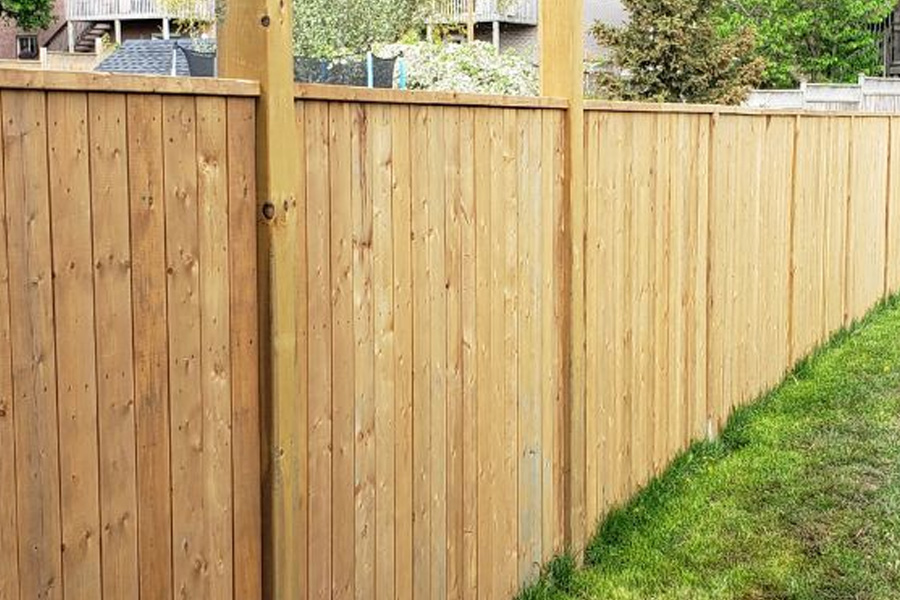How to Maintain Wooden Fences Through All Seasons

Image Source: wakefieldfencing.co.uk
Wooden fences offer a classic and timeless charm to any property. Their aesthetic appeal, paired with functionality, makes them a popular choice across Britain. However, the variable British climate—ranging from heavy rains and frost to scorching summers—can take a toll on wooden fences. To ensure their longevity, regular maintenance is essential, particularly when they are exposed to all seasons. This guide will take you through the best practices to maintain your wooden fence year-round, ensuring it remains in peak condition through spring, summer, autumn, and winter.
1. Understanding the Impact of British Weather on Wooden Fences
Wooden fences, no matter how durable, are susceptible to weather conditions. In Leeds and surrounding areas, fences face frequent rain, high humidity, and occasional frost, all of which can weaken wood over time. The moisture absorbed by the wood during the wet season can cause it to swell and warp, while hot, dry summers can lead to shrinkage and cracking. Leeds fencing companies often advise proactive care to combat these changes.
Fencing in Leeds, and particularly wooden types, must be inspected regularly for signs of damage, ensuring that timely maintenance keeps them looking good and functioning well year-round.
2. Spring Maintenance
Spring is an ideal time to inspect your wooden fence, especially after the cold and wet winter months. This is when you’ll most likely find any damage caused by frost, moisture, or wind.
Inspect for Loose Nails and Hardware:
During the winter months, the constant expansion and contraction of wood caused by freezing and thawing can loosen nails and other hardware. Replace or refasten loose nails or screws to ensure your fence remains structurally sound.
Clean Your Fence:
Over the winter, fences may accumulate dirt, algae, and mould. Use a pressure washer or a hose with a gentle cleaning solution (mix of water and mild detergent) to clean your wooden fence. Removing these elements helps prevent rot and keeps your fence looking fresh.
Inspect for Rot and Termites:
Spring is also a good time to check for signs of rot or pest infestations like termites. Wooden fences can become a hotspot for pests during the winter, especially if they are exposed to moisture. If you notice any rotting or insect damage, consult with a Leeds fencing expert for repair or replacement.
Apply a Protective Treatment:
After thoroughly cleaning and drying the fence, apply a protective wood treatment such as a weatherproof stain or sealant. This helps to protect your wooden fence from the increased humidity of the warmer months. Leeds fencing professionals often recommend choosing a sealant that offers both UV protection and water resistance.
3. Summer Maintenance
Summer brings heat and extended exposure to the sun, which can be particularly harsh on wood. While the British summer might not be as intense as in other regions, prolonged sunlight can cause wooden fences to fade and dry out.
Check for Cracks and Splitting:
As the heat of summer causes wood to dry, it may crack or split. Regularly inspect your fence, paying close attention to areas that receive direct sunlight. If you find small cracks, you can use wood filler to seal them before they worsen.
Reapply UV Protection:
To combat sun damage, ensure your fence is treated with a UV-resistant wood stain or sealant. This not only prevents the wood from fading but also ensures that it retains its natural beauty throughout the season. Reapply the protective coating if necessary.
Water Sparingly:
Summer often means garden hoses, sprinklers, and rain showers. Avoid soaking your wooden fence in water, as this can lead to warping. Instead, use water sparingly and ensure the area around your fence has proper drainage to prevent water from pooling near the wood.
Leeds fencing experts also recommend pruning plants or bushes around your fence to allow air circulation, reducing moisture retention on the wood.
4. Autumn Maintenance
Autumn brings cooler temperatures and increased rainfall, which can cause the wood to absorb excess moisture, leading to warping and rotting.
Remove Debris:
Fallen leaves and debris can collect around the base of your fence, creating damp environments that encourage rot and attract pests. Regularly clear any leaves, twigs, and debris to keep the area dry.
Inspect for Fungus:
Fungi and mould thrive in the damp conditions of autumn. Keep an eye out for black or green growths on your fence, as these are common signs of fungal infection. Use a fungicide or a mixture of vinegar and water to clean the affected areas, ensuring the fungus does not spread.
Prepare for Winter:
Autumn is also the time to prepare your fence for the colder months. Apply a fresh coat of sealant to protect against moisture and ensure that any cracks or holes are sealed to prevent snow or ice from getting in.
Trim Overhanging Branches:
Before winter hits, it’s essential to trim any branches or vegetation hanging over your fence. Heavy snow or ice can weigh down these branches, causing them to fall and potentially damage your fence.
Leeds fencing professionals often suggest a full inspection of fences before winter sets in, as cold and wet conditions can exacerbate minor issues if left unaddressed.
5. Winter Maintenance
Winter in the UK can be harsh, with a combination of freezing temperatures, frost, and occasional snowstorms. These conditions can lead to cracking, warping, and water damage if fences are not properly maintained.
Clear Snow Regularly:
After heavy snowfall, clear snow off your fence as soon as possible. The weight of snow can weaken your wooden fence and cause warping. Use a broom or a soft brush to gently remove snow, avoiding any tools that might scratch or damage the wood.
Monitor for Frost Damage:
The constant freezing and thawing cycle can cause wood to expand and contract, leading to cracks or even breakage. Inspect your fence regularly during the winter months, and immediately repair any signs of frost damage to prevent further deterioration.
Check Post Stability:
The ground can become saturated during the winter, loosening fence posts. Ensure that all posts remain securely in the ground. If you notice any wobbling, consult with a fencing Leeds specialist to assess and correct the issue.
Reapply a Water-Repellent Sealant:
Winter is one of the most challenging seasons for wooden fences, and the best way to protect your fence is to ensure it’s well-sealed. A water-repellent sealant can prevent moisture from seeping into the wood, thus avoiding rot and water damage.
Maintaining a wooden fence in a climate as varied as Leeds can be challenging, but with regular care, you can significantly extend the life and appearance of your fence. Year-round maintenance—whether it’s cleaning and treating in spring, protecting from the sun in summer, preparing for autumn rains, or winter-proofing—will ensure your wooden fence stays in top condition through all seasons. Care Fencing have written a great post here about Seasonal Maintenance Tips for Wooden Fences.
By following these seasonal maintenance tips, you’ll not only protect your investment but also keep your property looking its best. And for those seeking expert advice, fencing Leeds companies like Care Fencing offer professional services to ensure that your wooden fence can withstand whatever the British weather throws at it. So, whether you’re maintaining an existing structure or installing new Leeds fencing, always prioritise regular care to ensure its longevity and appeal.




